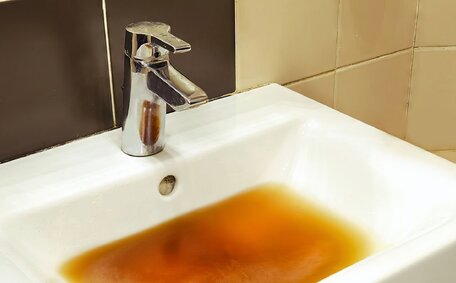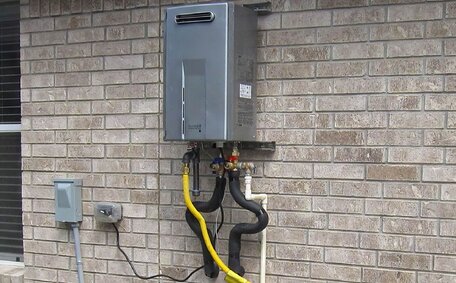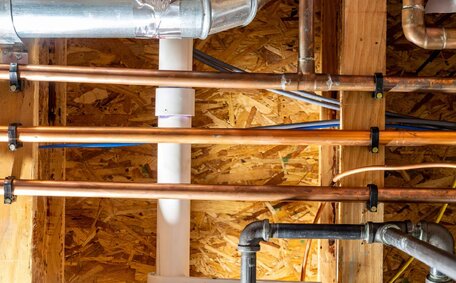Understanding Your Home’s Water System
In a typical Vaucluse home, water enters from the main water line in the street, passes through the water metre outside or downstairs, then travels into supply pipes that branch out to fixtures like sinks, showers, and toilets. The water heater and outdoor taps may be equipped with individual stop taps for precise water control in your property.
It’s vital to know where your stop tap is so you can turn off your mains in an emergency, such as a major leak, or when repairs are necessary. This is usually in a box underground, downstairs in the garage, or where you turn off your mains as the water line enters your home.
There may also be an inside stop valve located under sinks or behind toilets.
Being familiar with your stop valves can swiftly turn off your home’s water should a stressful situation like flooding occur. We’re here to guide you on how do you locate, test, and label your shutoff valves for safe water flow control.
Locating the Main Water Shutoff Valve
Finding the main water shutoff valve is crucial before an emergency occurs. This valve allows you to cut off only your main water supply from entering your property. When located and labelled ahead of time, you can quickly turn off your water main if needed.
The water main isolation valve is usually near where the water line enters your home, either outside next to the water meter, under the kitchen sink, inside your basement or garage, or behind an access panel. It may be a gate valve, ball valve, or stop valve. Common spots to find a shut off main include:
- The water metre box outside
- Inside the garage or basement on the home’s main water line
- Behind a cover plate on the wall or floor near the home’s water line entry point
Locate your shut off main water valve, which may be stiff from mineral buildup. Test it annually and lubricate so it responds effectively when you need to turn off water to prevent damage your pipes might incur in an emergency. Labelling it under kitchen spaces or other areas clarifies how to turn off water, making it readily identifiable.
Contact your Vaucluse Plumbing team if you need help locating, accessing or operating your main water shutoff.
Identifying the Shutoff Valve Type
The two most common types of water shutoff valves in your property are gate valves and ball valves. Recognising the type of valves can help ensure proper operation.
Gate Valves
Gate valves have a wheel handle that turns a gate inside the valve body to control water flow. Turning the handle raises or lowers the gate. Fully open provides full water flow while fully closed stops flow.
Ball Valves
Water valves, such as ball valves, use a rotating ball inside with a hole through the middle. The ball hole either aligns or misaligns with inlet and outlet pipes to allow or prevent water passage. Handles are usually shaped to show flow direction.
If you’re unsure what type of main water shutoff valve is installed, contact Vaucluse Plumbing. We can identify it and demonstrate proper operation so you can safely turn water on and off.
Operating the Main Shutoff Valve
Pondering 'how do i manage my water supply?' Simply follow these steps:
- Find the main water shutoff valve located near your property. This is usually near your water meter or where you can turn off main water as it enters your Vaucluse home.
- Identify how the valve turn mechanism works, whether you have a gate valve or ball valve. Gate valves turn a wheel to raise/lower an internal gate. Ball valves rotate a ball with a hole through it.
- Make sure you have the correct valve to turn off water main and supply your entire property. Turning it should stop water flowing into your home’s plumbing system.
- Place a bucket underneath to catch drips, then cut off main water supply by rotating the valve slowly and smoothly. Turning too quickly can cause damage to your plumbing.
- To restore flow, reverse the process - open slowly after ensuring the off water main condition is resolved and check for leaks.
Test the internal stop valve tucked inside your meter box annually and lubricate the handle if needed so it operates easily in a water off situation. Contact Vaucluse Plumbing if you’re unsure how to safely shut off your water valve.
Releasing Water Pressure from Plumbing
After using the shut off water supply valve, residual water pressure may remain trapped in your plumbing system. This pressure from both hot cold water lines must be correctly managed by shutting off main water before attempting any repairs to avoid injury.
- Make sure all water fixtures like taps and showers have your water off after shutting the main valve.
- Locate the highest fixture in your home, often a bathroom tap or shower.
- Place a bucket underneath to catch any cold water, then turn that fixture on fully. Let it run until the flow stops.
- Check other fixtures until you’ve confirmed no more water flows in your pipes. Pressure is now released.
- Contact Vaucluse Plumbing if you have any concerns about safely releasing water pressure from plumbing.
Releasing pressure ensures no water remains to unexpectedly spray from pipes and if you have any issues, don’t hesitate to call us. Test lowest fixtures first after confirming no flow from highest. Call us if you encounter difficulties.
Turning Off Individual Fixture Valves
the main water shutoff valve, your Vaucluse home may have smaller shutoff valves installed under sinks, behind toilets, or near other fixtures. These isolation valves allow you to turn off water supply to specific fixtures without disrupting service to the rest of your home.
Turning off individual fixture valves that supply your specific areas is useful when you need to:
- Repair a leaky faucet or toilet
- Replace a faulty tap, valve or water-using appliance
- Prevent leaks while away on vacation
To use them, locate the valve near the problem fixture. Turn the valve to the open position after repairs are complete, ensuring it is ready for next use.
They are typically found behind a removable panel, in an inside stop position within a vanity cabinet, or accessed through a hole in the drywall, with an off valve present to control water. Slowly turn the valve to the closed position to stop water flow only to that item.
Testing and labelling these smaller shutoff valves periodically allows quick isolation of issues without needing to shut down all household water. Contact Vaucluse Plumbing if you have difficulties locating or operating valves under sinks or other fixtures.
Preventive Measures Before Extended Absence
When planning to be away from your property for an extended time, consider preventive measures for both plumbing & gas to avoid potential damage while you’re gone:
- Locate and test all water shutoff valves in your house, including the main valve and individual fixture valves. Ensure you can fully turn off your water supply and that all maintenance is carried out properly when necessary.
- Shut off your mains water supply at your stop tap. Double check that all fixtures such as taps and toilets have stopped flowing, ensuring your water supply off properly.
- Drain all water from pipes by opening taps to release pressure. Consider turning off water supply to appliances.
- Check for leaks and drips. Make repairs if needed before leaving.
- Place heavy items like cans in sinks in case drains leak while vacant.
- Have someone periodically check inside and outside your home while away.
- Know how to quickly shut off water in an emergency if still away when you planned to return.
Taking these preventive measures adds assurance that you won’t return to find extensive water damage. Contact Vaucluse Plumbing if you need help preparing plumbing systems before a prolonged absence.
Preparing for Plumbing Emergencies
Being prepared for a plumbing emergency can prevent costly damage and disruption in your Vaucluse home. We recommend adopting key steps to water your resolve and readiness:
- Keep the contact details for Vaucluse Plumbing handy, whether at home or your business, in case immediate assistance is needed with a water leak, burst pipes, or other urgent issues.
- Maintain access to your water shutoff valves so you can quickly cut the supply in an emergency until help arrives.
- Have essential tools available like buckets, towels, a pipe wrench and plunger.
- Schedule annual plumbing inspections to identify and address potential problems before they become emergencies.
- Watch for leaks and dripping taps which may indicate larger issues. Make repairs promptly.
- Take preventive measures like draining pipes and turning off water supplies before vacations.
Advanced preparation can make stressful situations more manageable and ensures you’re familiar with your local water system. Vaucluse Plumbing is always available for emergency plumbing needs big or small in your local area.
When to Call a Professional Plumber
As a homeowner, it’s important to know basic plumbing repairs. However, some issues require a professional plumber’s expertise.
It’s a good idea to contact Vaucluse Plumbing when you face:
- A major leak you cannot locate or stop
- A malfunctioning tankless water heater or traditional hot water system
- Backed up sewer lines
- Major flooding
- Faulty pipes or serious corrosion
- Inability to turn water on or off
- Inaccessible main shutoff valve
- Gas leaks
Our team of licenced, bonded, and insured plumbers can help, especially with burst water pipes, equipped with the skills and experience to diagnose issues and make repairs properly the first time. We use advanced techniques and get the job done quickly while following all codes and regulations.
For reliable plumbing repairs or installations, trust Vaucluse Plumbing. Contact us at 1300 349 338 or [email protected].






